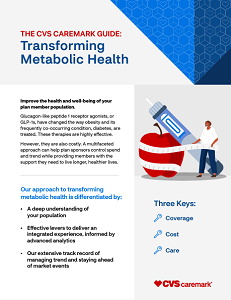GLP-1 Management Strategies
Frequently Asked Questions

As we continue our conversation on glucagon-like peptide 1 agonists (GLP-1s) and their role in treating metabolic health conditions, we’ve pulled together responses to some of your top questions related to coverage, cost, and care for this dynamic drug class.
Learn more
For a comprehensive overview of our customizable, integrated approach to GLP-1 management, check out our new CVS Caremark Guide: Transforming Metabolic Health.

COVERAGE: Plan design and formulary
Payors have differing philosophies on coverage for weight management drugs, which may vary based on plan demographics and employee attrition patterns. Some see coverage of weight management as an investment in the health of their population and expect to see medical cost savings in future years. Coverage of weight management medications may also help with employee retention and recruitment. In contrast, some plan sponsors may not be in a financial position to take on added drug spend and may choose to exclude these drugs.
Our account teams are prepared to consult with you on a coverage strategy that makes sense for your business and plan members, including flexible coverage options, if desired. Approximately 70 percent of our book of business commercial employer client lives (~55 percent of commercial employer clients) have coverage of weight loss medications.1
Formulary design encourages use of lower net cost products in the category. As of Feb. 15, 2024, Wegovy and Saxenda are preferred formulary agents in the GLP-1 class for weight management. Other weight management agents such as Qsymia, orlistat, and phentermine are also available on our standard template commercial formularies.
If your plan includes coverage for weight management medications, we will continue to leverage aggressive formulary and UM strategies to help ensure cost-effective, clinically appropriate coverage consistent with Food and Drug Administration (FDA)-approved labeling and clinical compendia. It is important to remember that competition from new entrants can help drive down costs.
Zephound is currently under new-to-market review with the CVS Caremark Pharmacy & Therapeutics Committee. Members who demonstrate a clinical need for the drug can get coverage through a medical exception process. We will continue to monitor the GLP-1 pipeline and evolve our formulary strategies to help drive competition and lower costs as new drugs come to market.
Additional market entrants are expected to drive competition and may lower prices. New drugs with different mechanisms of action may be more efficacious in some patient populations, with different adverse event profiles. As an example, the Amgen drug MariTide is showing impressive results in trials.2 New drugs are likely to translate to replacement spend, rather than incremental savings, at least in the short term.
COST: Utilization management
Our prior authorization (PA) criteria for GLP-1s are based on FDA-approved labeling and clinical compendia.
- PA requirements confirm that the member’s basal metabolic index (BMI) is consistent with product labeling (e.g., BMI ≥ 30 or a BMI ≥ 27 with comorbidities) and that the member has tried a comprehensive weight loss program including diet and increased physical activity.
- PA criteria include documentation requirements and drug-specific quantity limits for both initial and continuation of therapy requests.
- Re-authorization criteria help confirm that the member has lost weight and/or maintains their weight loss with continued use.
CVS Caremark’s UM for GLP-1s is designed to minimize therapy disruption for members with type 2 diabetes, while preventing coverage for off-label use of type 2 diabetes drugs for weight management.* Our smart logic PA helps to efficiently ensure clinically appropriate coverage for GLP-1 and GLP-1/GIP-1 diabetes medications by leveraging information we already have about a member, including prescription claims history. It looks for a diagnosis code for type 2 diabetes or previous use of diabetes medication or supplies. If the smart logic criteria are met, the medication is covered without disruption. If the criteria are not met, a PA request will need to be submitted.
Preliminary program results are promising:
- ~1,500 clients have enrolled in the program since the program launched in April 2023, including:
- 61% of commercial employer-sponsored lives
- 17% of commercial health plan lives**
- 67% of members meet smart logic criteria and do not require submission of a PA request
- 84% of PA requests result in denial, and
- 72% overall target fill rate***
- ~$1B or ~$4.86 PMPM in client savings3
These drugs are being studied in both weight- and non-weight-related conditions. Weight-related examples include exploring the potential for GLP-1s:
- Reduce the risk of cardiovascular events in adults with obesity and cardiovascular disease (CVD)
- Reduce complications from heart failure, sleep apnea, peripheral artery disease, and non-alcoholic steatohepatitis (NASH) in patients with obesity
Researchers are also evaluating the effects of GLP-1s on diabetic retinopathy and even Alzheimer’s disease. We are closely monitoring the pipeline to proactively share insights, clinical trials, and trend forecasting with you as they are released.
CVS Caremark’s Weight Management UM Bundle makes it easy for plan sponsors to keep up with the growing market for weight management drugs. The bundle automatically applies evidence-based UM criteria so you can manage coverage for new agents as soon as those criteria become available.† It currently includes criteria for Contrave, Qsymia, Saxenda, Wegovy, Xenical Zepbound, and additional weight management agents.††
Yes. We continually evolve our strategies and criteria based on market trends, insights, and new clinical information. In addition to enhancements we made to our criteria in January, we also are updating our smart logic PA offering. The process currently looks for use of diabetes medications or diabetes supplies in a member’s two-year claims history. Beginning May 1, 2024, it will exclude previous claims history of GLP-1 and GIP/GLP-1 diabetes drugs, including pen needles and syringes. Additionally, we will require 10 days between previous metformin fill and requested GLP-1 or GIP/GLP-1 drug.
CARE: Personalized clinical & nutrition support
Long-term weight loss maintenance is challenging, with high rates of relapse. CVS Health developed the CVS Weight Management program to provide personalized clinical and nutrition support to help members achieve more sustainable weight loss goals. For a member who is successful in utilizing a GLP-1, the co-therapy requirement is for 24 months; however, members may still be on longer if they determine, with their clinician, they need additional support. This time period allows for building the proper foundation for sustained lifestyle and nutrition change to support and maintain weight loss even beyond program enrollment.
The term “de-prescribing” is used frequently in the weight loss industry, so it is important to clarify what it means. De-prescribing is not the same as discontinuation. Discontinuation for GLP-1s is not clinically supported at this time, as current literature suggests members need to stay on the medication indefinitely. Members are only titrated off the medication if they want to stop using it, perhaps because the side effects are too disruptive, or they are not meeting the expected weight loss percentage in a given medication timeframe. Our team of clinicians will work with the member to suggest alternative options for better success while still providing weight management support.
Some vendors may also use the term “de-prescribing” to refer to changes in drug therapy that may be appropriate as a member loses weight. They may no longer need their medication for diabetes, high blood pressure or high cholesterol, for instance. Our team notifies the member’s primary care provider to help ensure care coordination, for maximum member support.
We assess members’ well-being and potential behavioral health issues as part of initial screening through Patient Health Questionnaire-2 (PHQ-2). Our registered dietitians also use motivational interviewing – an interactive, empathic listening style used to increase motivation and confidence when assessing ambivalence and motivation for lifestyle changes – in their coaching sessions. Additionally, we deliver education and personalized content related to behavioral health topics in the Health Optimizer app.
We improve health equity through program components aimed at leveling the playing field for all members, including virtual clinical support to help improve access regardless of location. Program dietitians have specialized training related to social determinants of health, and they develop curated nutrition plans that take into account culturally relevant diets, dietary restrictions, and food preferences.
In order to have a statistically significant way to measure the success of the program, we use a standard set of criteria, including BMI levels. To enroll, one of the following must apply:
- BMI ≥ 27 and an obesity-related comorbid condition
- BMI ≥ 30 with or without comorbid condition
Obesity-related comorbid conditions include but are not limited to diabetes, prediabetes, hypertension, dyslipidemia, CAD, osteoarthritis, and obstructive sleep apnea. Exclusion criteria apply.
We may enhance the program to allow customized enrollment criteria in the future. For now, any requests for program customization are considered on a case-by-case basis and can be discussed with your account representative.
Yes. Our program is priced at $148 per engaged member per month (PEMPM). To stay engaged, members must:
- Attend at least one live virtual meeting or member-initiated chat with a program clinician each month
- Log at least one biomarker (e.g., body weight) in the Health Optimizer app each month
Our proven care model is backed by a 2:1 return on investment (ROI) guarantee, with incremental savings through benefit integration.
-
1 CVS Health Analytics, February 2024. PBM claims data, PA episode summary data, and Clinical Authorization System for CVS Health Book of Business, Commercial Clients (Health Plan + Employer). Claims data for restricted-data clients excluded. Weight management medications include all obesity and anorexiants agents.
-
-
3 Savings as of November 2023. CVS Health Analytics, 2023. PBM claims data for CVS Health Book of Business, Commercial Clients (Health Plan + Employer), April 15 – November 30, 2023. Claims data for restricted clients excluded.
Actual results may vary depending on benefit plan design, member demographics, programs implemented by the plan and other factors.
This document contains references to brand-name prescription drugs that are trademarks or registered trademarks of pharmaceutical manufacturers not affiliated with CVS Health.
**Health plan client adoption is typically lower due to higher rates of customization.
***Includes claims approved through smart logic PA and PA
†The Weight Management UM Bundle is available to clients utilizing the following template formularies: Advanced Control Formulary, Advanced Control Formulary Chart, Advanced Control Choice Formulary, Basic Control Formulary, Basic Control Formulary Chart, Standard Control Formulary, Standard Control Formulary Chart, Standard Control Choice Formulary, Standard Opt-Out, and Standard Opt-Out Chart. There may be rebate impact to adopting the Weight Management UM Bundle. There are no additional charges to implement the Weight Management UM Bundle. Clients will pay the appropriate PA and appeals fees depending on their respective contracts.
††Includes select non-GLP-1 weight management agents: benzphetamine, diethylpropion, phendimetrazine, phentermine.